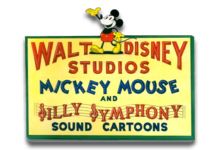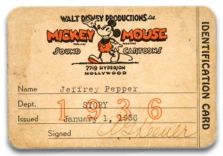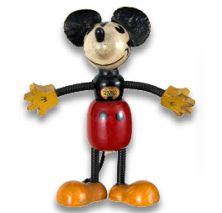A few miles from the Magic Kingdom — and beyond the boundaries of imagination — Walt Disney's greatest dream is becoming reality. EPCOT Center opens October 1, 1982. A showplace more than twice the size of the Magic Kingdom, EPCOT Center represents the ultimate in Disney-imagineered entertainment. An entertainment experience that will thrill your most "thrillable" sense of all — imagination.
Come ... imagine yourself the EPCOT traveler, exploring the corridors of time and the countries of this world today. Discovering exhilarating new visions of the future and the family of man.
 Future World
Future World
Travel the corridors of time and discover the future.Standing 180 feet above the entrance, its reflective surface fired by the Florida sun, EPCOT Center's colossal globe is your gateway to Future World. It is the largest structure of its kind anywhere, a dazzling statement to the extraordinary wonders that await you. Wonders in energy. In communications. In transportation. In the limitless potential of the seas... the land ... and most of all, in the limitless potential of human imagination to chart the course for this, our Spaceship, Earth.
Travel the realms of Future World and discover each of these wonders brought to life through the marvelous wizardry of Disney imagineering. Imagineering pushed to unprecedented heights for shows and adventures never before possible on such a grand scale. For you, an entertainment encounter of the ultimate kind.
Spaceship Earth
Spiral through the vast interior of the EPCOT Center globe aboard Spaceship Earth, presented by the Bell System. You're on a time journey from the dawn of recorded history to the sunrise of another future. Under the starry blackness of the world's largest projection dome, you'll see Earth as few have seen it before — a Spaceship adrift in the midnight sky.
Universe of EnergyThe creation of fossil fuel out of the chaos of storms, volcanoes and earthquakes is part of the drama that surrounds you on your voyage through the Universe of Energy, presented by Exxon. Set within a solar-powered building the size of three football fields, this electrifying show will dazzle you with some of the most sophisticated special effects ever developed — putting you in the center of the action on your energy chase to the future.
Transportation
A kaleidoscope of lights from a futuristic city-scape sets in motion the grand finale of your travels through the Transportation Pavilion, presented by General Motors. The pavilion is large enough to cover all the Magic Kingdom's Main Street, U.S.A., and presents one of the most whimsical "road shows" ever — a tongue-in-cheek adventure past the milestones of man's ever-accelerating mobility.
 The Land
The Land
In the six-acre Land Pavilion, presented by Kraft, you'll explore Nature in both her wildest and most cultivated states You'll see actual experiments in futuristic farming, like lettuce thriving in outer space, tomatoes growing from ceilings and melons from walls. Plus, you'll enjoy a zany cast of incredible edibles serving up some of the most palatable entertainment this side of the refrigerator.
EPCOT Computer Central
EPCOT Computer Central, presented by Sperry Univac, is one of the many exhibits in Communicore — Future World's global Main Street of ideas and inventions. Here, you'll have a firsthand look at the computer wizardry that helps make Disney imagineering possible.
Journey Into ImaginationAlmost castle-like in grandeur, the Imagination Pavilion, presented by Kodak, is the fantasyland of Future World. From the Dreamport, you'll follow Dreamfinder and his delightful sidekick, Figment, into the wondrous worlds; of art, literature, science and technology. In lmageWorks, a fun-packed electronic factory, you'll try your own hand at creative experiments. Then enter the Magic Journeys Theatre for a multi-dimensional motion picture of almost unimaginable scope.
New Horizons
An underwater colony is one of the future habitats highlighting your journey through New Horizons, presented by General Electric, In the Omnimax Theatre, you'll spiral through eight-story-high projections of the macro and micro worlds that form the building blocks of our future. And you'll take a whimsical look backwards at the tomorrows imagined by visionaries of the past.
 World Showcase
World Showcase
Travel the countries of the world and discover the family of man.Imagine in one day... you've breakfasted on tea and biscuits in England... followed the roads leading to Rome. Lunched in a Bavarian Beer Garden during Oktoberfest. Explored the interior marvels of a Mayan pyramid. Crossed the vast expanse of Canada and the Great Wall of China. Relaxed by a clear blue pond in the formal gardens of a Japanese pagoda. Dined in gourmet splendor under a moonlit Eiffel Tower. And watched more than 350 years of American history come to life in one of the most inspiring theatrical experiences ever conceived.
In World Showcase, you will do all this and more. Here, amidst nations standing in friendship beside a broad lagoon, you'll live adventures that only weeks of world travel could surpass. You'll explore shops filled with unusual foreign goods. Dine in restaurants filled with the aroma of authentic foreign foods. And meet the young people of foreign lands, working together in a true family of man.
American Adventure
In the American Adventure, presented by American Express and Coca-Cola, you'll join Ben Franklin and Mark Twain for a soaring historical overview of America and her promising future. Perhaps the most breathtaking show ever presented about "the nation of many nations," the American Adventure is a theatrical production unparalleled in Disney annals — combining large-screen projection, inspiring music and special effects with performances by, the most lifelike AudioAnimatronic figures ever developed.
Japan
A giant red Torii proclaims good luck as you pass the massive gateway to the Japan pavilion. Beyond it, an ornate pagoda invites you to explore beautiful Japanese gardens. The towers of an impressive feudal castle loom in the background. And in a large department store presenting the best in Japanese art and industry, you'll enjoy an exciting adventure in Oriental dining prepared at your table by Japanese master chefs.
Canada
From a northwest Indian village to a 19th century French chateau and the winding, narrow streets of Quebec City, the remarkable diversity of Canadian cultures and the awesome majesty of the wilderness are captured in Canada pavilion.
United Kingdom
Green lawns, gabled rooftops, shops along cobblestone streets and a charming waterside pub provide a typically "British" setting for the United Kingdom pavilion.
 China
China
In the China pavilion, you'll be surrounded by Circle Vision 360 presenting spectacular — never before filmed — footage of the dramatic landscapes, architecture and culture of the People's Republic.
Germany
Surrounded by picturesque medieval shops filleg with porcelain dolls, cuckoo clocks and hand- carved music boxes, a Bavarian Beer Garden; in the midst of a continuous Oktoberfest celebration is the centerpiece of the Germany pavilion.
Mexico
Beyond the tall Mayan pyramid of the Mexico pavilion, you'll enter a lakeside pueblo village complete with shops, a restaurant and a grumbling volcano spewing lava in the background. You'll then embark on a boat ride through Mexico's colorful past, discovering along the way the festival and dance of the great Mayan, Toltec and Aztec civilizations.
FranceThe flavor and romance of Paris at the turn of the last century come to life in the France pavilion, where your discoveries include the marketplace des Holies, small Parisian shops and a bistro and sidewalk cafe presenting the classic cuisines of three internationally famous French chefs.
ItalyA Venetian canal takes you to St. Mark's Square at the Italy pavilion. Handcrafted leather goods, pottery and glass figurines fill the shops. In an exquisite facsimile of the world famous Doge's Palace, you'll find a treasure-trove of fine art, jewelry and crystal, plus a splendid Italian restaurant operated by Alfredo's The Original of Rome.
 2719 Hyperion reader Jason Saldivar contacted me after last week's Rollercoaster Rabbit Freeze Frame! to point out another great Roger Rabbit detail, this one in the 1993 cartoon Trail Mix-Up. When Roger goes into a full-blown panic over a very small bug, the green-fumed insecticide he uses carries the brand name "MINK-OFF." This is a clever tribute to Rob Minkoff, the film's co-executive producer. Minkoff also worked as an animator on several Disney features including The Black Cauldron, The Great Mouse Detective and The Little Mermaid.
2719 Hyperion reader Jason Saldivar contacted me after last week's Rollercoaster Rabbit Freeze Frame! to point out another great Roger Rabbit detail, this one in the 1993 cartoon Trail Mix-Up. When Roger goes into a full-blown panic over a very small bug, the green-fumed insecticide he uses carries the brand name "MINK-OFF." This is a clever tribute to Rob Minkoff, the film's co-executive producer. Minkoff also worked as an animator on several Disney features including The Black Cauldron, The Great Mouse Detective and The Little Mermaid. I have to admit that up until just moments before putting together this post, I was still stymied. Then recognition suddenly dawned on me. The reference is as equally obscure as its moment in the film.
I have to admit that up until just moments before putting together this post, I was still stymied. Then recognition suddenly dawned on me. The reference is as equally obscure as its moment in the film. The character is from the Disney-produced 1992 animated short Off His Rockers. Here's a description of the film from Dave Smith's Disney A-Z:
The character is from the Disney-produced 1992 animated short Off His Rockers. Here's a description of the film from Dave Smith's Disney A-Z:
































































